Zenan Zhou
S2SBench: A Benchmark for Quantifying Intelligence Degradation in Speech-to-Speech Large Language Models
May 20, 2025Abstract:End-to-end speech large language models ((LLMs)) extend the capabilities of text-based models to directly process and generate audio tokens. However, this often leads to a decline in reasoning and generation performance compared to text input, a phenomenon referred to as intelligence degradation. To systematically evaluate this gap, we propose S2SBench, a benchmark designed to quantify performance degradation in Speech LLMs. It includes diagnostic datasets targeting sentence continuation and commonsense reasoning under audio input. We further introduce a pairwise evaluation protocol based on perplexity differences between plausible and implausible samples to measure degradation relative to text input. We apply S2SBench to analyze the training process of Baichuan-Audio, which further demonstrates the benchmark's effectiveness. All datasets and evaluation code are available at https://github.com/undobug/S2SBench.
ReSearch: Learning to Reason with Search for LLMs via Reinforcement Learning
Mar 27, 2025



Abstract:Large Language Models (LLMs) have shown remarkable capabilities in reasoning, exemplified by the success of OpenAI-o1 and DeepSeek-R1. However, integrating reasoning with external search processes remains challenging, especially for complex multi-hop questions requiring multiple retrieval steps. We propose ReSearch, a novel framework that trains LLMs to Reason with Search via reinforcement learning without using any supervised data on reasoning steps. Our approach treats search operations as integral components of the reasoning chain, where when and how to perform searches is guided by text-based thinking, and search results subsequently influence further reasoning. We train ReSearch on Qwen2.5-7B(-Instruct) and Qwen2.5-32B(-Instruct) models and conduct extensive experiments. Despite being trained on only one dataset, our models demonstrate strong generalizability across various benchmarks. Analysis reveals that ReSearch naturally elicits advanced reasoning capabilities such as reflection and self-correction during the reinforcement learning process.
DualToken: Towards Unifying Visual Understanding and Generation with Dual Visual Vocabularies
Mar 19, 2025Abstract:The differing representation spaces required for visual understanding and generation pose a challenge in unifying them within the autoregressive paradigm of large language models. A vision tokenizer trained for reconstruction excels at capturing low-level perceptual details, making it well-suited for visual generation but lacking high-level semantic representations for understanding tasks. Conversely, a vision encoder trained via contrastive learning aligns well with language but struggles to decode back into the pixel space for generation tasks. To bridge this gap, we propose DualToken, a method that unifies representations for both understanding and generation within a single tokenizer. However, directly integrating reconstruction and semantic objectives in a single tokenizer creates conflicts, leading to degraded performance in both reconstruction quality and semantic performance. Instead of forcing a single codebook to handle both semantic and perceptual information, DualToken disentangles them by introducing separate codebooks for high and low-level features, effectively transforming their inherent conflict into a synergistic relationship. As a result, DualToken achieves state-of-the-art performance in both reconstruction and semantic tasks while demonstrating remarkable effectiveness in downstream MLLM understanding and generation tasks. Notably, we also show that DualToken, as a unified tokenizer, surpasses the naive combination of two distinct types vision encoders, providing superior performance within a unified MLLM.
Baichuan-Audio: A Unified Framework for End-to-End Speech Interaction
Feb 24, 2025Abstract:We introduce Baichuan-Audio, an end-to-end audio large language model that seamlessly integrates audio understanding and generation. It features a text-guided aligned speech generation mechanism, enabling real-time speech interaction with both comprehension and generation capabilities. Baichuan-Audio leverages a pre-trained ASR model, followed by multi-codebook discretization of speech at a frame rate of 12.5 Hz. This multi-codebook setup ensures that speech tokens retain both semantic and acoustic information. To further enhance modeling, an independent audio head is employed to process audio tokens, effectively capturing their unique characteristics. To mitigate the loss of intelligence during pre-training and preserve the original capabilities of the LLM, we propose a two-stage pre-training strategy that maintains language understanding while enhancing audio modeling. Following alignment, the model excels in real-time speech-based conversation and exhibits outstanding question-answering capabilities, demonstrating its versatility and efficiency. The proposed model demonstrates superior performance in real-time spoken dialogue and exhibits strong question-answering abilities. Our code, model and training data are available at https://github.com/baichuan-inc/Baichuan-Audio
MM-Verify: Enhancing Multimodal Reasoning with Chain-of-Thought Verification
Feb 19, 2025Abstract:According to the Test-Time Scaling, the integration of External Slow-Thinking with the Verify mechanism has been demonstrated to enhance multi-round reasoning in large language models (LLMs). However, in the multimodal (MM) domain, there is still a lack of a strong MM-Verifier. In this paper, we introduce MM-Verifier and MM-Reasoner to enhance multimodal reasoning through longer inference and more robust verification. First, we propose a two-step MM verification data synthesis method, which combines a simulation-based tree search with verification and uses rejection sampling to generate high-quality Chain-of-Thought (COT) data. This data is then used to fine-tune the verification model, MM-Verifier. Additionally, we present a more efficient method for synthesizing MMCOT data, bridging the gap between text-based and multimodal reasoning. The synthesized data is used to fine-tune MM-Reasoner. Our MM-Verifier outperforms all larger models on the MathCheck, MathVista, and MathVerse benchmarks. Moreover, MM-Reasoner demonstrates strong effectiveness and scalability, with performance improving as data size increases. Finally, our approach achieves strong performance when combining MM-Reasoner and MM-Verifier, reaching an accuracy of 65.3 on MathVista, surpassing GPT-4o (63.8) with 12 rollouts.
Ocean-OCR: Towards General OCR Application via a Vision-Language Model
Jan 26, 2025



Abstract:Multimodal large language models (MLLMs) have shown impressive capabilities across various domains, excelling in processing and understanding information from multiple modalities. Despite the rapid progress made previously, insufficient OCR ability hinders MLLMs from excelling in text-related tasks. In this paper, we present \textbf{Ocean-OCR}, a 3B MLLM with state-of-the-art performance on various OCR scenarios and comparable understanding ability on general tasks. We employ Native Resolution ViT to enable variable resolution input and utilize a substantial collection of high-quality OCR datasets to enhance the model performance. We demonstrate the superiority of Ocean-OCR through comprehensive experiments on open-source OCR benchmarks and across various OCR scenarios. These scenarios encompass document understanding, scene text recognition, and handwritten recognition, highlighting the robust OCR capabilities of Ocean-OCR. Note that Ocean-OCR is the first MLLM to outperform professional OCR models such as TextIn and PaddleOCR.
Baichuan-Omni-1.5 Technical Report
Jan 26, 2025Abstract:We introduce Baichuan-Omni-1.5, an omni-modal model that not only has omni-modal understanding capabilities but also provides end-to-end audio generation capabilities. To achieve fluent and high-quality interaction across modalities without compromising the capabilities of any modality, we prioritized optimizing three key aspects. First, we establish a comprehensive data cleaning and synthesis pipeline for multimodal data, obtaining about 500B high-quality data (text, audio, and vision). Second, an audio-tokenizer (Baichuan-Audio-Tokenizer) has been designed to capture both semantic and acoustic information from audio, enabling seamless integration and enhanced compatibility with MLLM. Lastly, we designed a multi-stage training strategy that progressively integrates multimodal alignment and multitask fine-tuning, ensuring effective synergy across all modalities. Baichuan-Omni-1.5 leads contemporary models (including GPT4o-mini and MiniCPM-o 2.6) in terms of comprehensive omni-modal capabilities. Notably, it achieves results comparable to leading models such as Qwen2-VL-72B across various multimodal medical benchmarks.
Med-R$^2$: Crafting Trustworthy LLM Physicians through Retrieval and Reasoning of Evidence-Based Medicine
Jan 21, 2025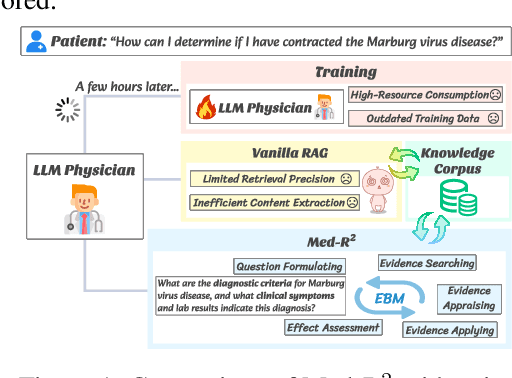
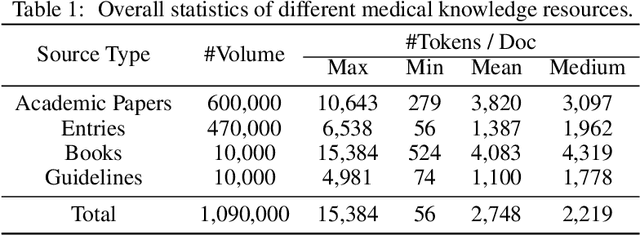
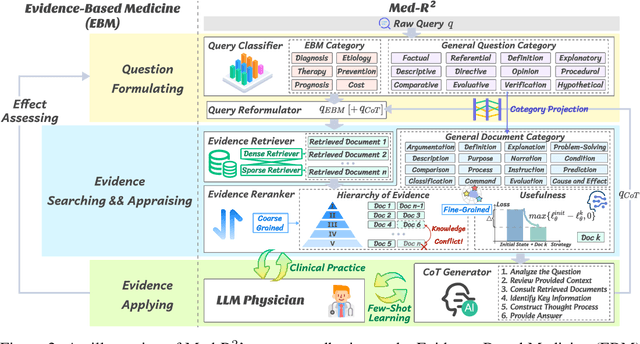
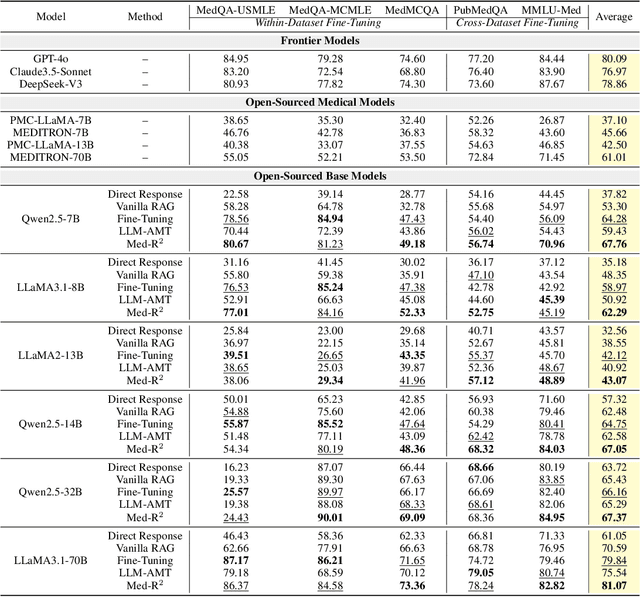
Abstract:In recent years, Large Language Models (LLMs) have exhibited remarkable capabilities in clinical scenarios. However, despite their potential, existing works face challenges when applying LLMs to medical settings. Strategies relying on training with medical datasets are highly cost-intensive and may suffer from outdated training data. Leveraging external knowledge bases is a suitable alternative, yet it faces obstacles such as limited retrieval precision and poor effectiveness in answer extraction. These issues collectively prevent LLMs from demonstrating the expected level of proficiency in mastering medical expertise. To address these challenges, we introduce Med-R^2, a novel LLM physician framework that adheres to the Evidence-Based Medicine (EBM) process, efficiently integrating retrieval mechanisms as well as the selection and reasoning processes of evidence, thereby enhancing the problem-solving capabilities of LLMs in healthcare scenarios and fostering a trustworthy LLM physician. Our comprehensive experiments indicate that Med-R^2 achieves a 14.87\% improvement over vanilla RAG methods and even a 3.59\% enhancement compared to fine-tuning strategies, without incurring additional training costs.
VersaTune: An Efficient Data Composition Framework for Training Multi-Capability LLMs
Dec 02, 2024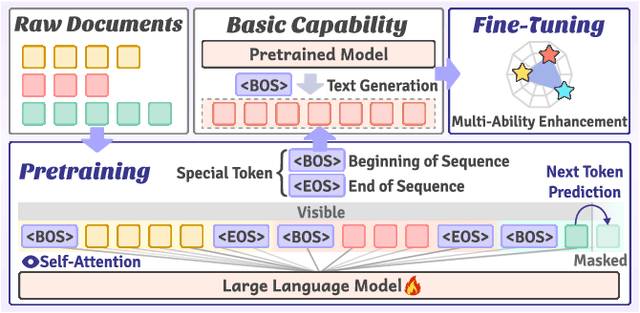



Abstract:Large-scale pretrained models, particularly Large Language Models (LLMs), have exhibited remarkable capabilities in handling multiple tasks across domains due to their emergent properties. These capabilities are further augmented during the Supervised Fine-Tuning (SFT) phase. Despite their potential, existing work mainly focuses on domain-specific enhancements during fine-tuning, the challenge of which lies in catastrophic forgetting of knowledge across other domains. In this study, we introduce VersaTune, a novel data composition framework designed for enhancing LLMs' overall multi-ability performances during training. We categorize knowledge into distinct domains including law, medicine, finance, science, code, etc. We begin with detecting the distribution of domain-specific knowledge within the base model, followed by the training data composition that aligns with the model's existing knowledge distribution. During the training process, domain weights are dynamically adjusted based on their learnable potential and forgetting degree. Experimental results demonstrate that VersaTune achieves significant improvements in multi-domain performance, with an 35.21% enhancement in comprehensive multi-domain tasks. Additionally, in scenarios where specific domain optimization is required, VersaTune reduces the degradation of performance in other domains by 38.77%, without compromising the target domain's training efficacy.
Beyond Sight: Towards Cognitive Alignment in LVLM via Enriched Visual Knowledge
Nov 25, 2024Abstract:Does seeing always mean knowing? Large Vision-Language Models (LVLMs) integrate separately pre-trained vision and language components, often using CLIP-ViT as vision backbone. However, these models frequently encounter a core issue of "cognitive misalignment" between the vision encoder (VE) and the large language model (LLM). Specifically, the VE's representation of visual information may not fully align with LLM's cognitive framework, leading to a mismatch where visual features exceed the language model's interpretive range. To address this, we investigate how variations in VE representations influence LVLM comprehension, especially when the LLM faces VE-Unknown data-images whose ambiguous visual representations challenge the VE's interpretive precision. Accordingly, we construct a multi-granularity landmark dataset and systematically examine the impact of VE-Known and VE-Unknown data on interpretive abilities. Our results show that VE-Unknown data limits LVLM's capacity for accurate understanding, while VE-Known data, rich in distinctive features, helps reduce cognitive misalignment. Building on these insights, we propose Entity-Enhanced Cognitive Alignment (EECA), a method that employs multi-granularity supervision to generate visually enriched, well-aligned tokens that not only integrate within the LLM's embedding space but also align with the LLM's cognitive framework. This alignment markedly enhances LVLM performance in landmark recognition. Our findings underscore the challenges posed by VE-Unknown data and highlight the essential role of cognitive alignment in advancing multimodal systems.
 Add to Chrome
Add to Chrome Add to Firefox
Add to Firefox Add to Edge
Add to Edge